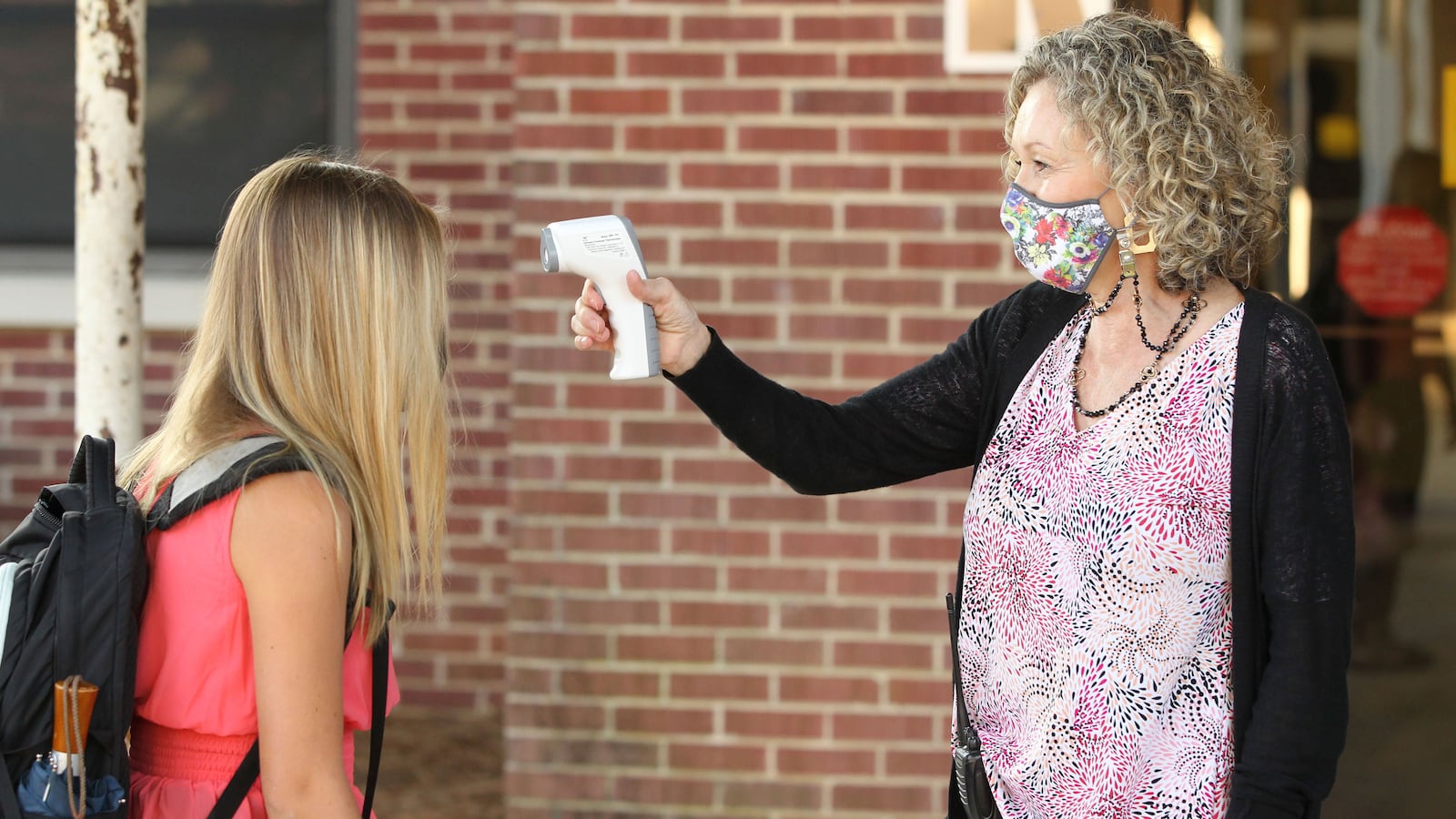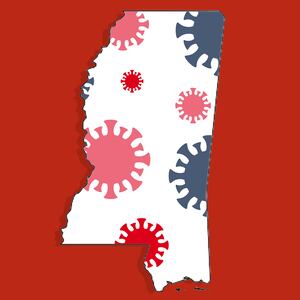On Monday morning, hundreds of sixth, seventh, and eighth graders filed through the doors at Grenada Middle School in north Mississippi.
Looking out of her classroom, math teacher Suzanne Alexander saw kids huddled together, giddy at being with friends for the first time in months. As she walked the halls, students she hadn’t seen since they moved to remote learning in March surprised her with big, enthusiastic hugs. When the bell rang at the end of the day, those same students hung out around classroom doors, waiting on friends—perhaps too intimidated, in normal middle school fashion, to be seen walking out alone.
It was, she said, a very typical first day of school. And that was the problem.
“Right now is not normal by any stretch of the imagination,” Alexander told The Daily Beast. “And they don’t even think about it. But I’m thinking, ‘Oh my goodness, there are 50 kids huddled up around me.’”
“We keep preaching, ‘Don’t gather in groups.’ Well, when you’ve got kids, they’re going to gather in groups. That’s just the nature of kids.”
Last week, as Mississippi led the country in per capita deaths from the coronavirus, schools around the state began holding in-person classes in defiance of the state's own medical experts, who had pushed for a delayed start to the year. As has frequently been the case since he took office in January, the opinion of the one person able to mandate delaying the start date for schools statewide, Gov. Tate Reeves, a Republican, has largely tracked with that of President Trump, who issued an all-caps edict on Twitter last month that “SCHOOLS MUST OPEN IN THE FALL!!!”
A slew of red states have begun moving forward with in-person classes. As of Thursday, Alabama, Indiana, Georgia and Oklahoma had started to reopen schools and, in some cases, quarantined students after reopening classes, with an Atlanta-area school’s packed hallways—and subsequent mass contagion—going, well, viral.
But in Mississippi, the results have been remarkably dire. By the end of its first week, the Corinth School district had been forced to quarantine over 120 students and staff. Later that week, a longtime football coach at Lafayette High School died after quarantining with coronavirus symptoms. And on Monday, just as another group of school districts opened their doors, the state confirmed COVID cases in 22 schools. One day later, Gulfport High School sent 100 students to quarantine at home after a teacher there reported symptoms. On Wednesday, the Rankin County School District, which will begin holding in-person classes next week, announced its superintendent had tested positive for COVID-19.
And these aren't even schools in the region of the state with the highest rates of coronavirus infections. The governor ordered those middle and high schools to delay reopening until Aug. 17.
“What these numbers let me know is that we did it too soon. And it’s going to get worse,” said Erica Jones, president of the Mississippi Association of Educators, the biggest teacher’s union in the state. “All it takes is one student to come in with the virus and ‘boom,’ the spread is there.”
As states around the country weigh the merits of in-person learning, Mississippi is becoming a lesson in how quickly reopening schools could turn a first wave into a tsunami. For teachers, this is a terrifying prospect: Many of them are locked into contracts they signed back in February, before the virus was even a major threat in this state. And reneging on them isn't an option.
In Mississippi, breaking a signed contract can cost teachers their license.
“I feel like a guinea pig,” said Summer Nation, a ceramics instructor at Germantown High School in Gluckstadt. “The rest of the country is looking at us, saying, ‘Let’s see what happens with Mississippi.’ And I can see it already. It’s a tidal wave, and the floodgates are about to open.”
Representatives for the Madison and Grenada School Districts did not immediately respond to a request for comment. But Gov. Reeves has defended the decision to allow in-person classes even as schools continue to confirm new cases, noting that the risk of viral spread among children is low. And last week, as the Corinth School District, which was the first in the state to open its doors, swiftly moved to quarantine over 100 students, Reeves admitted in an interview on Fox News that “we recognize that we're taking risks. But in today's world, in 2020, there is no scenario whereby we can eliminate 100 percent of the risk.”
To support this position, Trump and Reeves have argued that the risk of viral spread remains low among children. But earlier this this week, the American Academy of Pediatric and the Children’s Hospital Association released a study showing that cases of coronavirus in children had risen 90 percent in the last month. Mississippi had the fifth-highest number of childhood coronavirus cases per capita.
“If you make a big decision like reopening schools, you have to get your ducks in a row,” said Dr. William Schaffner, a professor of preventive medicine and infectious disease at Vanderbilt University Medical Center in Nashville. “If the state doesn’t do a good job controlling community spread, I think one school after another will have outbreaks and kids, of course, will take the virus home to their families. And then the schools will become an accelerant of this virus.”
The University of Mississippi Medical Center, the biggest hospital in Mississippi, announced last week that its ICU was beyond capacity. Schaffner said expecting to safely open schools in a place like Mississippi, which leads the country in nearly every indicator of viral spread, was akin to “magical thinking.”
Last month, the Mississippi Association of Educators surveyed 2400 teachers statewide, finding that the vast majority, 86 percent, feared returning to in-person instruction. But their efforts to lobby the Department of Education—which oversees the state’s 138 school districts—and Gov. Reeves did little to move the needle. Reeves even defied the advice of his own state health officer, Dr. Thomas Dobbs, who had publicly urged delaying physical school reopening until at least September, noting in a July 31 Facebook Live discussion that “there’s nothing special about August.”
In an email to The Daily Beast, the Mississippi Department of Education responded to criticism by saying that only the governor has the legal authority to delay school reopening statewide. And while they said “there is no authority given to the State Board of Education” to direct school reopening plans, the same email noted statewide changes that the board had made, from granting districts the flexibility to implement a combination of traditional, remote, and hybrid learning, to reducing the number of class hours required each day by nearly a third.
Last week, with some districts already holding classes and new coronavirus infections up over 250 percent since the start of summer, Reeves ordered middle and high schools to delay all classes until Aug. 17—but only in eight of Mississippi’s 82 counties, where the spread of the virus was highest. He also issued Mississippi’s first statewide mask mandate.
It expires next Tuesday, the day after schools in those eight counties are allowed to reopen.
In response to criticism, Renae Eze, communications director for Gov. Reeves, said in an email that there were also health benefits to keeping schools open.
“The risk of keeping schools closed becomes a decision between public health vs. public health, as Dr. [Robert] Redfield of the CDC said recently, with millions of children across our country not having access to mental health services, food and nutrition, abuse reporting, the effectiveness of in-person learning, and socialization—all of which they receive at school.”
But she also noted Reeves and state health experts would continue to monitor the situation and planned to step in should “a school or district need additional guidance and resources. All options in our response efforts for this pandemic remain on the table.”
Teachers said the lack of response from state leaders felt familiar. For years, Mississippi teacher salaries have been among the lowest in the nation. Last year, lawmakers boosted salaries by $1,500—to just below $34,000 for new hires, still one of the five lowest salaries in the country.
“It not only speaks to undervaluing teachers but it also speaks to undervaluing public schools and public school students,” Alexander said.
“This feels like an experiment,” she added. “And I know a lot of other teachers who’ve been saying that when it gets bad enough, they’ll send everyone home again to do remote learning.”
Reeves’s office did not respond when asked if there would be a threshold at which the governor would order schools to resume remote-only instruction, as he had done in March. In his Facebook Live discussion, Dobbs said the decision to close right now would likely be based on individual schools or districts, with some schools moving to remote-only learning when positive tests reached five percent. Dr. Alan Jones, who leads the clinical response for COVID-19 at the University of Mississippi Medical Center, called testing “one prong that could be used for safe reopening.” But rather than ramping up testing, as students returned to schools last week, the number of tests statewide actually dropped 13 percent.
Nation, who teaches ceramics in Gluckstadt, said she’s preparing to move to online-only instruction, ordering tools that she can send home with each student. She just doesn’t know when that will be.
“But how bad does it have to get? Is it a certain number of cases? Is it one death? Well, we’ve already had one teacher who died.”







